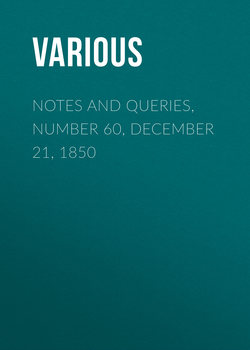Читать книгу Notes and Queries, Number 60, December 21, 1850 - Various - Страница 3
Queries
ОглавлениеBIBLIOGRAPHICAL QUERIES
(Continued from p. 441.)
(25.) Has there been but a single effort made to immortalise among printers Valentine Tag? Mercier, Abbé de Saint-Léger, in his Supplément à l'Hist. de l'Imprimerie, by Marchand, p. 111., accuses Baron Heinecken of having stated that this fictitious typographer set forth the Fables Allemandes in 1461. Heinecken, however, had merely quoted six German lines, the penultimate of which is
intimating only that the work had been concluded on St. Valentine's day.
(26.) Can there be any more fruitful source of error with respect to the age of early printed books than the convenient system of esteeming as the primary edition that in which the date is for the first time visible? It might be thought that experienced bibliographers would invariably avoid such a palpable mistake; but the reverse of this hypothesis is unfortunately true. Let us select for an example the case of the Vita Jesu Christi, by the Carthusian Ludolphus de Saxonia, a work not unlikely to have been promulgated in the infancy of the typographic art. Panzer, Santander, and Dr. Kloss (189.) commence with an impression at Strasburg, which was followed by one at Cologne, in 1474. Of these the former is mentioned by Denis, and by Bauer also (ii. 315.). Laire notes it likewise (Ind. Par., i. 543.: cf. 278.), but errs in making Eggestein the printer, as no account of him is discernible after 1472. (Meerman, i. 215.) Glancing at the misconceptions of Maittaire and Wharton, who go no farther back than the years 1478 and 1483 respectively, let us return to the suppressed editio princeps of 1474. De Bure (Théol., pp. 121-2.) records a copy, and gives the colophon. He says, "Cette édition, qui est l'originale de cet ouvrage, est fort rare;" and his opinion has been adopted by Seemiller (i. 61.), who adds, "Litteris impressum est hoc opus sculptis." In opposition to all these eminent authorities, I will venture to express my belief that the earliest edition is one which is undated. A volume in the Lambeth collection, without a date, and entered in Dr. Maitland's List, p. 42., is thus described therein: "Folio, eights, Gothic type, col. 57 lines;" and possibly the printer's device (List, p. 348.) might be appropriated by I. Mentelin, of Strasburg. To this book, nevertheless, we must allot a place inferior to what I would bestow upon another folio, in which the type is particularly Gothic and uneven, and in which each of the double columns contains but forty-seven lines, and the antique initial letters sometimes used are plainly of the same xylographic race as that one with which the oldest Viola Sanctorum is introduced. It may be delineated, in technical terms, as being sine loco, anno, et nomine typographi. Car. sigg., paginarum num. et custodd. Vocum character majusculus est, ater, crassus, et rudis. Why should not Mentz have been the birthplace of this book? for there it appears that the author's MS. was "veneratione non parva" preserved, and there he most probably died. I would say that it was printed between 1465 and 1470. It is bound up with a Fasciculus Temporum, Colon. 1479, which looks quite modern when compared with it, and its beginning is: "De Vita hiesu a venerabili viro fratro (sic) Ludolpho Cartusiensi edita incipit feliciter." The leaves are in number forty-eight. At the end of the book itself is, "Explicit vita ihesu." Then succeeds a leaf, on the recto of which is a table of contents for the entire work and after its termination we find: "Explicit vita cristi de quatuor ewãgelistis et expositõne doctorum sanctorum sumpta."
(27.) Upon what grounds should Mr. Bliss (Vol. ii., p. 463.) refuse to be contented with the very accurate reprint of Cardinal Allen's Admonition to the Nobility and People of England and Ireland, with a Preface by Eupator (the Rev. Joseph Mendham), London, Duncan, 1842?
(28.) In an article on Ticknor's History of Spanish Literature, in the Quarterly Review for last September, p. 316, we read:
"The second Index Expurgatorius ever printed was the Spanish one of Charles V. in 1546."
Was the critic dreaming when he wrote these words? for, otherwise, how could he have managed to compress so much confusion into so small a space? To say nothing of "the second" Expurgatory Index, the first was not printed until 1571; and this was a Belgic, not a "Spanish one." It is stamped by its title-page as having been "in Belgia concinnatus," and it was the product of the press of Plantin, at Antwerp. With regard to the Indices Expurgatorii of Spain, the earliest of them was prepared by the command of Cardinal Quiroga, and issued by Gomez, typographer-royal at Madrid, in 1584. The copy in my hand, which belonged to Michiels, is impressed with his book-mark "première édition." Will the writer in the Quarterly Review
